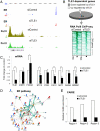Transducin-like enhancer protein 1 mediates estrogen receptor binding and transcriptional activity in breast cancer cells
- PMID: 21536917
- PMCID: PMC3286936
- DOI: 10.1073/pnas.1018863108
Transducin-like enhancer protein 1 mediates estrogen receptor binding and transcriptional activity in breast cancer cells
Abstract
Estrogen receptor (ER) binds to distal enhancers within the genome and requires additional factors, such as the Forkhead protein FoxA1, for mediating chromatin interactions. We now show that the human Groucho protein, Transducin-like enhancer protein 1 (TLE1), positively assists some ER-chromatin interactions, a role that is distinct from its general role as a transcriptional repressor. We show that specific silencing of TLE1 inhibits the ability of ER to bind to a subset of ER binding sites within the genome, a phenomenon that results in perturbations in phospho-RNA Pol II recruitment. Furthermore, TLE1 is essential for effective ER-mediated cell division. We have discovered a distinct role for TLE1, as a necessary transcriptional component of the ER complex, where it facilitates ER-chromatin interactions.
Conflict of interest statement
The authors declare no conflict of interest.
Figures




References
-
- Ali S, Coombes RC. Endocrine-responsive breast cancer and strategies for combating resistance. Nat Rev Cancer. 2002;2:101–112. - PubMed
-
- Cirillo LA, et al. Opening of compacted chromatin by early developmental transcription factors HNF3 (FoxA) and GATA-4. Mol Cell. 2002;9:279–289. - PubMed
-
- Carroll JS, et al. Chromosome-wide mapping of estrogen receptor binding reveals long-range regulation requiring the forkhead protein FoxA1. Cell. 2005;122:33–43. - PubMed
Publication types
MeSH terms
Substances
Grants and funding
LinkOut - more resources
Full Text Sources
Medical
Molecular Biology Databases
Research Materials
Miscellaneous

